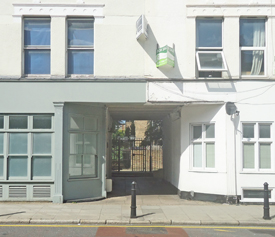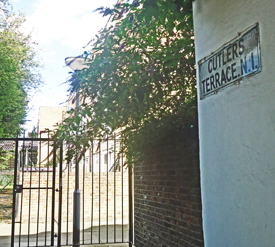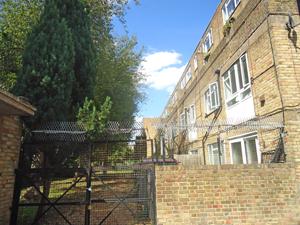|
Cutlers Almshouses 98 Balls Pond Road, Kingsland, N1 4BF
|
In 1838 the Court of Assistants of the Cutlers Company resolved to build some almshouses to add to "the welfare and comfort of their poorer Brethren and Sisters", and accordingly voted some funds for that purpose.
A piece of land in the Balls Pond Road was purchased and the foundation stone was laid on 25th June 1839. By 1842 only seven of the intended 12 almshouses had been completed at a cost of £2,000, but they were immediately occupied by poor freemen and liverymen of the Company, or their widows.
The 2-storey terraced block was eventually finished. Built in the Gothic Revival style, it lay at right-angles to the Balls Pond Road, with its frontage following the line of the East Villas of the Metropolitan Benefits Societies Asylum. The central section had a porch surmounted by a gable, on the front of which was the Cutlers Company arms. Each almshouse contained three rooms, and each had its own yard. The residents received a liberal allowance from the Company.
During WW2 (1939-1945) the buildings sustained some blast damage from bombs, as did much of the neighbourhood.
By 1964 the Company regarded the almshouses as 'uninhabitable'. The buildings were sold.
Current status
During the 1960s the site of the almshouses was redeveloped by Islington Council. It became Cutlers Terrace, a cul-de-sac off the Balls Pond Road.N.B. Photographs obtained in August 2017

When the almshouses were originally built in the 1840s there were no buildings alongside them in th Balls Pond Road. However, as the street was developed for housing over the years, they were cut off. Access to Cutlers Terrace is through a small passageway tunnel under a building in the Balls Pond Road.

The passageway leads to the gate of Cutlers Terrace.

Cutlers Terrace.
References (Accessed 28th September 2020)
Lewis S 1842 The History and Topography of the Parish of Saint Mary, Islington, in the County of Middlesex. London, JH Jackson.
http://edithsstreets.blogspot.com
https://collage/cityoflondon.gov.uk
https://en/wikisource.org
www.british-history.ac.uk
www.islington.gov.uk (1)
www.islington.gov.uk (2)
Last updated 4th October 2020
Click here to return to Almshouses of London alphabetical list
Click here to return to home page